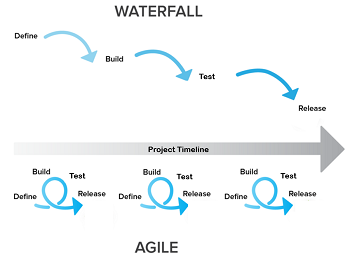Agile – Buzzword and reality – Edition 2
A couple of weeks ago my trainee companion Hampus wrote about additive manufacturing (AM) and compared the functionality of the technology in real life versus the “Buzzword” and its expectations. With that, I though it would be a fun subject to continue with, but regarding agile work methods instead.
You probably already know something about the subject, under the last period of my studies it felt like I heard it from every company I talked to. Everybody “works agile” and pushed on the fact that this is the way to go for organisations to be able to still be a strong contender in their respective industry. Although, since no company actually explained why they used that method and merely spoke about the positive affects without any concrete explaination I got a relatively negative association to the buzzword. It only felt as is the companies brought it up to be trendy and be seemed as an attractive employer for newly graduated students.
For you who has never heard of it before, or you who are where I stood earlier and only heard the positive sides of it without any clear explanation to why that is; here is a short introduction to what the agile method actually is.
The easiest way to explain the agile working method is to compare it to the traditional methods, the so called waterfall method. In this classic project methodology you use sequential phases such as define, build, test and release. Every phase has to be completed before moving on to the next and the project can not go back to a previous stage. Most commonly you work with the entire product you want to release in to the market. However, with the agile methodology you are using iterative cycles where you have the same four steps as mentioned previously but you do it in small batches (sprints) multiple times instead where you work with a smaller part of the whole product during each batch (increment). For an easy comparison between the two methodologies, see figure underneath.

After learned more about the concept and had the opportunity to be involved in a team at GKN utilising this way of working I have to say that all of my negative associations towards the buzzword has completely disappeared, since you can clearly see the advantages it provides. But instead of me talking your ears off it is better if I just list the top three things I believe that agile working improves.
Reducing complexity and difficulty while planning (define phase)
Since perfect information does not exist the waterfall method is difficult to use proficiently in real life, due to the fact that you will learn more about the market, the product and future possibilities over time. This makes it less optimal when completing the planning stage which is what is done in the very beginning of the project, since the circumstances will most likely change. With an agile method of working the planning is instead done in each interactive cycle, which leads to being more flexible when it comes to changes.
Focusing on the real value of what the product can provide
You usually say that 80 percent of the value comes from 20 percent of the functionalities in a product. In the waterfall method you do not know what these 20 percent are until you deliver the product to the costumer who will find it themselves through using it. The agile method, however, creates small increments at a time instead of delivering the entire product immediatly. This provides the opportunity of showcasing these increments and communicating with the costumer which will further lead to finding the real value, and furthermore be able to focus on the imporant parts.
Reducing risks
Working with the agile method will also reduce risks during the product development stage through always delivering and presenting the increments of the finished product to the costumer. This will cause feedback to come at early stage in the process and as a result decreasing the time and cost of possible corrections, in comparison to doing changes on a complete product if the costumer is not satisfied.
Hope this small introduction to the buzzword “agile” was useful and provided a brief understanding that it actually provides more value than just marketing the product!
/Rasmus Tyft